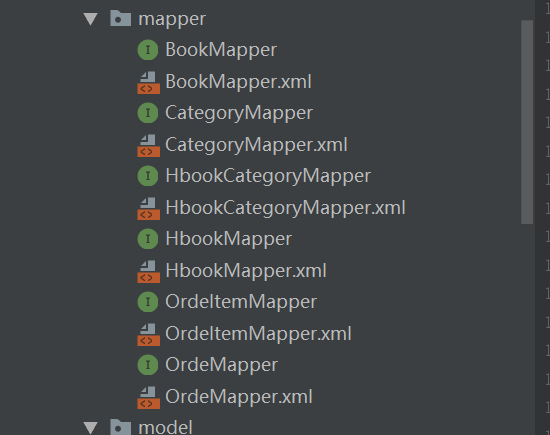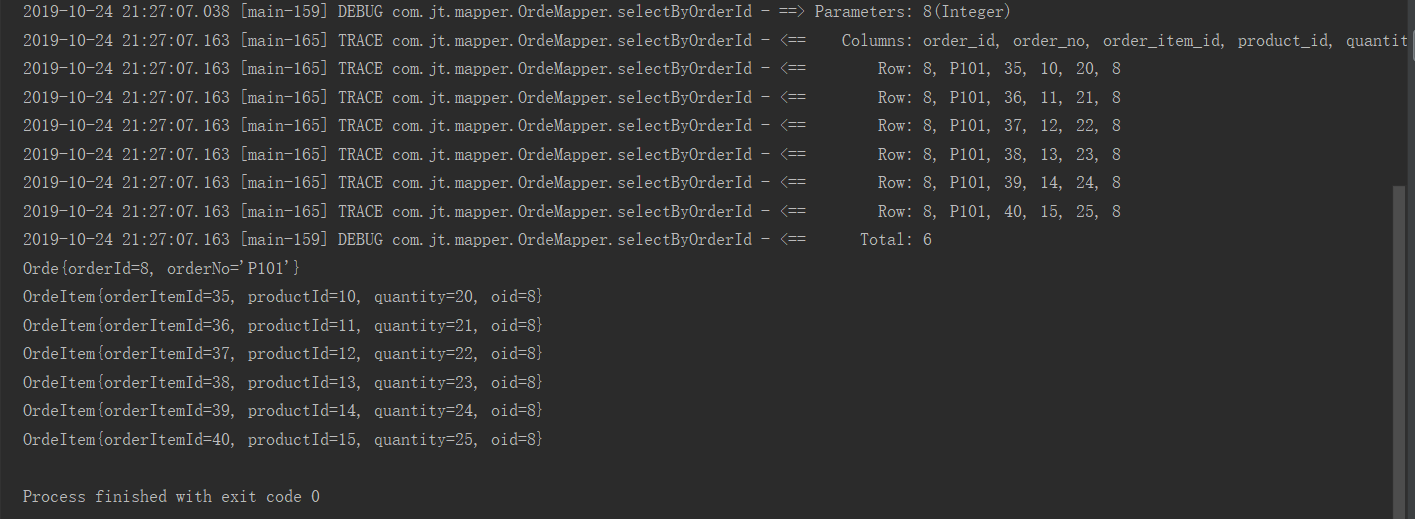mybatis之关联关系
前言:
在我们之前的hibernate中我们是学过了关联关系的,
所以我们在本章给讲一讲mybatis的关联关系。
mybatis的关联关系
一对多的测试
1.通过逆向工程生成Hbook,HbookCategory,Category
如何生成,可以参考之前的
这次我们要用到五张数据库表
<table schema="" tableName="t_hibernate_order" domainObjectName="Order"
enableCountByExample="false" enableDeleteByExample="false"
enableSelectByExample="false" enableUpdateByExample="false"> </table>
<table schema="" tableName="t_hibernate_order_item" domainObjectName="OrderItem"
enableCountByExample="false" enableDeleteByExample="false"
enableSelectByExample="false" enableUpdateByExample="false"> </table>
<table schema="" tableName="t_hibernate_book" domainObjectName="Hbook"
enableCountByExample="false" enableDeleteByExample="false"
enableSelectByExample="false" enableUpdateByExample="false"> </table>
<table schema="" tableName="t_hibernate_category" domainObjectName="Category"
enableCountByExample="false" enableDeleteByExample="false"
enableSelectByExample="false" enableUpdateByExample="false"> </table>
<table schema="" tableName="t_hibernate_book_category" domainObjectName="HbookCategory"
enableCountByExample="false" enableDeleteByExample="false"
enableSelectByExample="false" enableUpdateByExample="false"> </table>
生成之后目录

OrderVo
package com.jt.model.vo; import com.jt.model.Orde;
import com.jt.model.OrdeItem; import java.util.ArrayList;
import java.util.List; /**
* @author jt
* @site www.xiaomage.com
* @company xxx公司
* @create 2019-10-23 18:59
*/
public class OrderVo extends Orde {
private List<OrdeItem> orderItems=new ArrayList<>(); public List<OrdeItem> getOrderItems() {
return orderItems;
} public void setOrderItems(List<OrdeItem> orderItems) {
this.orderItems = orderItems;
}
}
OrderItemVo
package com.jt.model.vo; import com.jt.model.Orde;
import com.jt.model.OrdeItem; /**
* @author jt
* @site www.xiaomage.com
* @company xxx公司
* @create 2019-10-23 19:01
*/
public class OrderItemVo extends OrdeItem {
private Orde orde; public Orde getOrde() {
return orde;
} public void setOrde(Orde orde) {
this.orde = orde;
}
}
CategoryVo
package com.jt.model.vo; import com.jt.model.Category;
import com.jt.model.Hbook; import java.util.ArrayList;
import java.util.List; /**
* @author jt
* @site www.xiaomage.com
* @company xxx公司
* @create 2019-10-23 20:08
*/
public class CategoryVo extends Category {
private List<Hbook> hbooks=new ArrayList<>(); public List<Hbook> getHbooks() {
return hbooks;
} public void setHbooks(List<Hbook> hbooks) {
this.hbooks = hbooks;
}
}
HbookVo
package com.jt.model.vo; import com.jt.model.Category;
import com.jt.model.Hbook; import java.util.ArrayList;
import java.util.List; /**
* @author jt
* @site www.xiaomage.com
* @company xxx公司
* @create 2019-10-23 20:06
*/
public class HbookVo extends Hbook {
private List<Category> categories=new ArrayList<>(); // public List<Category> getCategories() {
// return categories;
// }
//
// public void setCategories(List<Category> categories)
// {
// this.categories = categories;
// } public List<Category> getCategories() {
return categories;
} public void setCategories(List<Category> categories) {
this.categories = categories;
}
}
4.做一个测试(根据id来查询)
@Test
public void selectByOrderItemId() {
List<OrderItemVo> orderItemVos = oneToManyService.selectByOrderItemId();
OrderItemVo orderItemVo=orderItemVos.get();
System.out.println(orderItemVo);
System.out.println(orderItemVo.getOrde());
} @Test
public void selectByOrderId() {
List<OrderVo> orderVos = oneToManyService.selectByOrderId();
OrderVo orderVo=orderVos.get();
// System.out.println(orderVos.size());
System.out.println(orderVo);
for (OrdeItem orderItem : orderVo.getOrderItems()) {
System.out.println(orderItem);
}
}
通过一个订单项的id,查询出订单项信息的同时,查询出所属的订单
通过一个订单id,查询出订单信息的同时,查询出所有的订单项
2、多对多关联关系
首先先用逆向生成工具生成t_hibernate_book、t_hibernate_book_category(可生成可不生成)、t_hibernate_category,这两张表对应的model与mapper
generatorConfig.xml
<?xml version="1.0" encoding="UTF-8" ?>
<!DOCTYPE generatorConfiguration PUBLIC "-//mybatis.org//DTD MyBatis Generator Configuration 1.0//EN"
"http://mybatis.org/dtd/mybatis-generator-config_1_0.dtd" >
<generatorConfiguration>
<!-- 引入配置文件 -->
<properties resource="jdbc.properties"/> <!--指定数据库jdbc驱动jar包的位置-->
<classPathEntry location="D:\\initpath\\mvn_repository\\mysql\\mysql-connector-java\\5.1.44\\mysql-connector-java-5.1.44.jar"/> <!-- 一个数据库一个context -->
<context id="infoGuardian">
<!-- 注释 -->
<commentGenerator>
<property name="suppressAllComments" value="true"/><!-- 是否取消注释 -->
<property name="suppressDate" value="true"/> <!-- 是否生成注释代时间戳 -->
</commentGenerator> <!-- jdbc连接 -->
<jdbcConnection driverClass="${jdbc.driver}"
connectionURL="${jdbc.url}" userId="${jdbc.username}" password="${jdbc.password}"/> <!-- 类型转换 -->
<javaTypeResolver>
<!-- 是否使用bigDecimal, false可自动转化以下类型(Long, Integer, Short, etc.) -->
<property name="forceBigDecimals" value="false"/>
</javaTypeResolver> <!-- 指定javaBean生成的位置 -->
<!-- targetPackage:指定生成的model生成所在的包名 -->
<!-- targetProject:指定在该项目下所在的路径 -->
<javaModelGenerator targetPackage="com.jt.model"
targetProject="src/main/java">
<!-- 是否允许子包,即targetPackage.schemaName.tableName -->
<property name="enableSubPackages" value="false"/>
<!-- 是否对model添加构造函数 -->
<property name="constructorBased" value="true"/>
<!-- 是否针对string类型的字段在set的时候进行trim调用 -->
<property name="trimStrings" value="false"/>
<!-- 建立的Model对象是否 不可改变 即生成的Model对象不会有 setter方法,只有构造方法 -->
<property name="immutable" value="false"/>
</javaModelGenerator> <!-- 指定sql映射文件生成的位置 -->
<sqlMapGenerator targetPackage="com.jt.mapper"
targetProject="src/main/java">
<!-- 是否允许子包,即targetPackage.schemaName.tableName -->
<property name="enableSubPackages" value="false"/>
</sqlMapGenerator> <!-- 生成XxxMapper接口 -->
<!-- type="ANNOTATEDMAPPER",生成Java Model 和基于注解的Mapper对象 -->
<!-- type="MIXEDMAPPER",生成基于注解的Java Model 和相应的Mapper对象 -->
<!-- type="XMLMAPPER",生成SQLMap XML文件和独立的Mapper接口 -->
<javaClientGenerator targetPackage="com.jt.mapper"
targetProject="src/main/java" type="XMLMAPPER">
<!-- 是否在当前路径下新加一层schema,false路径com.oop.eksp.user.model, true:com.oop.eksp.user.model.[schemaName] -->
<property name="enableSubPackages" value="false"/>
</javaClientGenerator> <!-- 配置表信息 -->
<!-- schema即为数据库名 -->
<!-- tableName为对应的数据库表 -->
<!-- domainObjectName是要生成的实体类 -->
<!-- enable*ByExample是否生成 example类 -->
<!--<table schema="" tableName="t_book" domainObjectName="Book"-->
<!--enableCountByExample="false" enableDeleteByExample="false"-->
<!--enableSelectByExample="false" enableUpdateByExample="false">-->
<!--<!– 忽略列,不生成bean 字段 –>-->
<!--<!– <ignoreColumn column="FRED" /> –>-->
<!--<!– 指定列的java数据类型 –>-->
<!--<!– <columnOverride column="LONG_VARCHAR_FIELD" jdbcType="VARCHAR" /> –>-->
<!--</table>--> <!-- <table schema="" tableName="t_hibernate_order" domainObjectName="Orde"
enableCountByExample="false" enableDeleteByExample="false"
enableSelectByExample="false" enableUpdateByExample="false">
<!– 忽略列,不生成bean 字段 –>
<!– <ignoreColumn column="FRED" /> –>
<!– 指定列的java数据类型 –>
<!– <columnOverride column="LONG_VARCHAR_FIELD" jdbcType="VARCHAR" /> –>
</table>--> <!--<table schema="" tableName="t_hibernate_order_item" domainObjectName="OrdeItem"
enableCountByExample="false" enableDeleteByExample="false"
enableSelectByExample="false" enableUpdateByExample="false">
<!– 忽略列,不生成bean 字段 –>
<!– <ignoreColumn column="FRED" /> –>
<!– 指定列的java数据类型 –>
<!– < columnOverride column="LONG_VARCHAR_FIELD" jdbcType="VARCHAR" /> –>
</table>--> <table schema="" tableName="t_hibernate_book`" domainObjectName="Hbook"
enableCountByExample="false" enableDeleteByExample="false"
enableSelectByExample="false" enableUpdateByExample="false">
<!-- 忽略列,不生成bean 字段 -->
<!-- <ignoreColumn column="FRED" /> -->
<!-- 指定列的java数据类型 -->
<!-- <columnOverride column="LONG_VARCHAR_FIELD" jdbcType="VARCHAR" /> -->
</table> <!--<table schema="" tableName="t_hibernate_category" domainObjectName="Category"
enableCountByExample="false" enableDeleteByExample="false"
enableSelectByExample="false" enableUpdateByExample="false">
<!– 忽略列,不生成bean 字段 –>
<!– <ignoreColumn column="FRED" /> –>
<!– 指定列的java数据类型 –>
<!– <columnOverride column="LONG_VARCHAR_FIELD" jdbcType="VARCHAR" /> –>
</table>--> <!-- <table schema="" tableName="t_hibernate_book_category" domainObjectName="HbookCategory"
enableCountByExample="false" enableDeleteByExample="false"
enableSelectByExample="false" enableUpdateByExample="false">
<!– 忽略列,不生成bean 字段 –>
<!– <ignoreColumn column="FRED" /> –>
<!– 指定列的java数据类型 –>
<!– <columnOverride column="LONG_VARCHAR_FIELD" jdbcType="VARCHAR" /> –>
</table>--> </context>
</generatorConfiguration>
HBookMapper
package com.jt.mapper; import com.jt.model.Hbook;
import com.jt.model.vo.HbookVo;
import org.apache.ibatis.annotations.Param;
import org.springframework.stereotype.Repository; @Repository
public interface HbookMapper {
int deleteByPrimaryKey(Integer bookId); int insert(Hbook record); int insertSelective(Hbook record); Hbook selectByPrimaryKey(Integer bookId); int updateByPrimaryKeySelective(Hbook record); int updateByPrimaryKey(Hbook record); HbookVo selectByBid(@Param("bid") Integer bid);
}
HBookMapper.xml
<?xml version="1.0" encoding="UTF-8" ?>
<!DOCTYPE mapper PUBLIC "-//mybatis.org//DTD Mapper 3.0//EN" "http://mybatis.org/dtd/mybatis-3-mapper.dtd" >
<mapper namespace="com.jt.mapper.HbookMapper" >
<resultMap id="BaseResultMap" type="com.jt.model.Hbook" >
<constructor >
<idArg column="book_id" jdbcType="INTEGER" javaType="java.lang.Integer" />
<arg column="book_name" jdbcType="VARCHAR" javaType="java.lang.String" />
<arg column="price" jdbcType="REAL" javaType="java.lang.Float" />
</constructor>
</resultMap> <resultMap id="HbookVoMap" type="com.jt.model.vo.HbookVo">
<result property="bookId" column="book_id"></result>
<result property="bookName" column="book_name"></result>
<result property="price" column="price"></result>
<!-- <result property="orderItems"></result>-->
<collection property="categories" ofType="com.jt.model.Category">
<result property="categoryId" column="category_id"></result>
<result property="categoryName" column="category_name"></result>
</collection>
</resultMap> <sql id="Base_Column_List" >
book_id, book_name, price
</sql>
<select id="selectByPrimaryKey" resultMap="BaseResultMap" parameterType="java.lang.Integer" >
select
<include refid="Base_Column_List" />
from t_hibernate_book
where book_id = #{bookId,jdbcType=INTEGER}
</select>
<delete id="deleteByPrimaryKey" parameterType="java.lang.Integer" >
delete from t_hibernate_book
where book_id = #{bookId,jdbcType=INTEGER}
</delete>
<insert id="insert" parameterType="com.jt.model.Hbook" >
insert into t_hibernate_book (book_id, book_name, price
)
values (#{bookId,jdbcType=INTEGER}, #{bookName,jdbcType=VARCHAR}, #{price,jdbcType=REAL}
)
</insert>
<insert id="insertSelective" parameterType="com.jt.model.Hbook" >
insert into t_hibernate_book
<trim prefix="(" suffix=")" suffixOverrides="," >
<if test="bookId != null" >
book_id,
</if>
<if test="bookName != null" >
book_name,
</if>
<if test="price != null" >
price,
</if>
</trim>
<trim prefix="values (" suffix=")" suffixOverrides="," >
<if test="bookId != null" >
#{bookId,jdbcType=INTEGER},
</if>
<if test="bookName != null" >
#{bookName,jdbcType=VARCHAR},
</if>
<if test="price != null" >
#{price,jdbcType=REAL},
</if>
</trim>
</insert>
<update id="updateByPrimaryKeySelective" parameterType="com.jt.model.Hbook" >
update t_hibernate_book
<set >
<if test="bookName != null" >
book_name = #{bookName,jdbcType=VARCHAR},
</if>
<if test="price != null" >
price = #{price,jdbcType=REAL},
</if>
</set>
where book_id = #{bookId,jdbcType=INTEGER}
</update>
<update id="updateByPrimaryKey" parameterType="com.jt.model.Hbook" >
update t_hibernate_book
set book_name = #{bookName,jdbcType=VARCHAR},
price = #{price,jdbcType=REAL}
where book_id = #{bookId,jdbcType=INTEGER}
</update> <select id="selectByBid" resultMap="HbookVoMap" >
select * from t_hibernate_book b,t_hibernate_book_category bc,t_hibernate_category c
where b.book_id=bc.bid and bc.cid=c.category_id
and b.book_id=#{bid}
</select>
</mapper>
HBookCategoryMapper
package com.jt.mapper;
import com.jt.model.HbookCategory;
public interface HbookCategoryMapper {
int deleteByPrimaryKey(Integer bcid);
int insert(HbookCategory record);
int insertSelective(HbookCategory record);
HbookCategory selectByPrimaryKey(Integer bcid);
int updateByPrimaryKeySelective(HbookCategory record);
int updateByPrimaryKey(HbookCategory record);
}
HBookCategoryMapper.xml
<?xml version="1.0" encoding="UTF-8" ?>
<!DOCTYPE mapper PUBLIC "-//mybatis.org//DTD Mapper 3.0//EN" "http://mybatis.org/dtd/mybatis-3-mapper.dtd" >
<mapper namespace="com.jt.mapper.HbookCategoryMapper" >
<resultMap id="BaseResultMap" type="com.jt.model.HbookCategory" >
<constructor >
<idArg column="bcid" jdbcType="INTEGER" javaType="java.lang.Integer" />
<arg column="bid" jdbcType="INTEGER" javaType="java.lang.Integer" />
<arg column="cid" jdbcType="INTEGER" javaType="java.lang.Integer" />
</constructor>
</resultMap>
<sql id="Base_Column_List" >
bcid, bid, cid
</sql>
<select id="selectByPrimaryKey" resultMap="BaseResultMap" parameterType="java.lang.Integer" >
select
<include refid="Base_Column_List" />
from t_hibernate_book_category
where bcid = #{bcid,jdbcType=INTEGER}
</select>
<delete id="deleteByPrimaryKey" parameterType="java.lang.Integer" >
delete from t_hibernate_book_category
where bcid = #{bcid,jdbcType=INTEGER}
</delete>
<insert id="insert" parameterType="com.jt.model.HbookCategory" >
insert into t_hibernate_book_category (bcid, bid, cid
)
values (#{bcid,jdbcType=INTEGER}, #{bid,jdbcType=INTEGER}, #{cid,jdbcType=INTEGER}
)
</insert>
<insert id="insertSelective" parameterType="com.jt.model.HbookCategory" >
insert into t_hibernate_book_category
<trim prefix="(" suffix=")" suffixOverrides="," >
<if test="bcid != null" >
bcid,
</if>
<if test="bid != null" >
bid,
</if>
<if test="cid != null" >
cid,
</if>
</trim>
<trim prefix="values (" suffix=")" suffixOverrides="," >
<if test="bcid != null" >
#{bcid,jdbcType=INTEGER},
</if>
<if test="bid != null" >
#{bid,jdbcType=INTEGER},
</if>
<if test="cid != null" >
#{cid,jdbcType=INTEGER},
</if>
</trim>
</insert>
<update id="updateByPrimaryKeySelective" parameterType="com.jt.model.HbookCategory" >
update t_hibernate_book_category
<set >
<if test="bid != null" >
bid = #{bid,jdbcType=INTEGER},
</if>
<if test="cid != null" >
cid = #{cid,jdbcType=INTEGER},
</if>
</set>
where bcid = #{bcid,jdbcType=INTEGER}
</update>
<update id="updateByPrimaryKey" parameterType="com.jt.model.HbookCategory" >
update t_hibernate_book_category
set bid = #{bid,jdbcType=INTEGER},
cid = #{cid,jdbcType=INTEGER}
where bcid = #{bcid,jdbcType=INTEGER}
</update>
</mapper>
测试方法
@Autowired
private ManyToManyService manyToManyService; @Test
public void selectByBid() {
HbookVo hbookVo = manyToManyService.selectByBid();
System.out.println(hbookVo);
for (Category category : hbookVo.getCategories()) {
System.out.println(category);
}
} @Test
public void selectByCid() {
CategoryVo categoryVo=this.manyToManyService.selectByCid();
System.out.println(categoryVo);
for (Hbook hbook : categoryVo.getHbooks()) {
System.out.println(hbook);
}
}

mybatis之关联关系的更多相关文章
- mybatis一对一关联关系映射
mybatis一对一关联关系映射 在关联关系中,有一对一,一对多,多对多三种关联关系. 一对一关系:在操作上,任意一方引入对方的主键作为外键. 一对多关系:在"多"的一方添加&qu ...
- MyBatis对象关联关系---- association与collection
Mybatis处理“一对多”的关系时,需要用到associasion元素.处理”多对一“用collection元素来实现(这两个元素在之前mapper文件中提到过). 本例子中,假设一名User可以有 ...
- mybatis之关联关系映射
Mybatis关联关系映射 1.一对多 首先先用逆向生成工具生成t_hibernate_order.t_hibernate_order_item 这两张表对应的model与mapper OrderVo ...
- MyBatis的关联关系补充 多对多 继承
多对多 一个学生有多个课程 一个课程有多个学生 思路分析 :使用一个中间表 用学生表和课程表的主键作为中间表的联合主键 1数据库表的设计 课程表 学生表 中间表 2/实体类的设计 课程类 public ...
- MyBatis的关联关系 一对一 一对多 多对多
一对一示例 一个妻子对应一个丈夫 数据库表设计时 在妻子表中添加一个丈夫主键的作为外键 1 对应的JavaBean代码虽然在数据库里只有一方配置的外键,但是这个一对一是双向的关系. Husband实体 ...
- Mybatis之关联关系(一对多、多对多)
目的: Mybatis关系映射之一对多 Mybatis关系映射之多对多 Mybatis关系映射之一对多 一对多 (订单对应多个订单项) 多对一 (订单项对应一个订单) 其是映射关系的基层思维是一样的 ...
- MyBatis对象关联关系----多对多的保存与查询
模拟情景: 对象:学生,课程 关系:一个学生可选多个课程,一门课程可被多个学生选择 一.保存 1.创建数据库表,student,course,student_course,其中student_cour ...
- mybatis学习笔记三(关联关系)
学习mybatis的关联关系,主要注解在代码上,这里不做解释.配置文件一样的就不贴了 1.关联关系表创建(学生对应老师 多对一) 学生老师表 2.表对应的实体类 package com.home.en ...
- Mybatis的关联映射案例
主要是对之前学习的关联映射做一个案例,自己动手实践一下,可以理解的更好一点. 开发环境 开发工具:idea Java环境: jdk1.8.0_121 数据库:SQLServer 项目结构,里面包含了三 ...
随机推荐
- IT兄弟连 HTML5教程 CSS3属性特效 弹性盒模型
CSS3引入了新的盒模型——弹性盒模型,该模型决定一个盒子在其他盒子中的分布方式以及如何处理可用的空间.使用该模型,可以很轻松的创建自适应浏览器窗口的流动布局或自适应字体大小的弹性布局.弹性盒模型看起 ...
- 一道ctf-内存取证volatility的学习使用
环境:kali 0x00 volatility官方文档 https://github.com/volatilityfoundation/volatility 在分析之前,需要先判断当前的镜像信息,分析 ...
- Java之封装与访问权限控制(一)
目录 Java之封装与访问权限控制(一) 封装的概念 访问控制符 属性私有化 Java之封装与访问权限控制(一) 对于封装的概念,我总觉得自己还是挺了解的,但是真要我说,还真说不出个啥来.我只能默默地 ...
- ECMAScript 5 特性
ECMAScript 5 也称为 ES5 和 ECMAScript 2009. ECMAScript 5 特性 这些是 2009 年发布的新特性: "use strict" 指令 ...
- oracle中创建用户、角色、权限、表空间简单使用
一.数据库用户 创建数据库用户 create user 用户名 identified by 密码; 授权 grant 权限名 to 用户名; 查看当前用户权限 select * from sessio ...
- Socket实现简易聊天室,Client,Server
package seday08; import java.io.BufferedWriter;import java.io.OutputStream;import java.io.OutputStre ...
- leaflet实现风场图(附源码下载)
前言 leaflet 入门开发系列环境知识点了解: leaflet api文档介绍,详细介绍 leaflet 每个类的函数以及属性等等 leaflet 在线例子 leaflet 插件,leaflet ...
- linux离线安装mysql5.7
下载安装包 下载地址:https://cdn.mysql.com//Downloads/MySQL-5.7/mysql-5.7.27-1.el7.x86_64.rpm-bundle.tar 上传到 / ...
- swiper手滑导航圆点不同步
// 滚动图 var mySwiper = new Swiper('.swiper-container', { // 如果需要分页器 pagination: { el: '.swiper-pagina ...
- day96_11_28 mongoDB与scrapy框架
一.mongodb mongodb是一个面向文档的数据库,而不是关系型数据库.不采用关系型是为了获得更好的扩展性. 它与mysql的区别在于它没有表连接,但是可以通过其他办法实现. 安装数据库. 上官 ...
